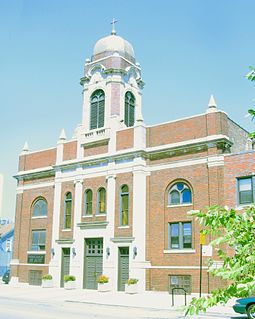| South Hammond | |
|---|---|
| Neighborhood | |
| Coordinates: 41°35′06″N87°31′26″W / 41.58500°N 87.52389°W Coordinates: 41°35′06″N87°31′26″W / 41.58500°N 87.52389°W | |
| Country | |
| State | |
| County | Lake County |
| City | Hammond |
| Time zone | CST (UTC-6) |
| • Summer (DST) | CDT (UTC-5) |
| ZIP code | 46324 |
| Area code(s) | 219 |
South Hammond is a neighborhood in southwestern Hammond, Indiana, approximately between the Illinois state line and Columbia Avenue, south of 165th Street. It is bounded to the east by Woodmar, to the south by the towns of Munster and Highland, to the west by Calumet City, Illinois, and to the north by Central Hammond. [1] The Little Calumet River snakes along the neighborhood's southern boundary. The neighborhood's boundaries correspond to Hammond's Planning District IV. [1]

Hammond is a city in Lake County, Indiana, United States. It is part of the Chicago metropolitan area. First settled in the mid-19th century, it is one of the oldest cities of northern Lake County. As of the 2010 United States census, it is also the largest in population: the 2010 population was 80,830, replacing Gary as the most populous city in Lake County. From north to south, Hammond runs from Lake Michigan down to the Little Calumet River; from east to west along its southern border, it runs from the Illinois state line to Cline Avenue. The city is traversed by numerous railroads and expressways, including the South Shore Line, Borman Expressway, and Indiana Toll Road.

Illinois is a state in the Midwestern region of the United States. It has the 5th largest Gross Domestic Product by state, is the 6th-most populous U.S. state and 25th-largest state in terms of land area. Illinois is often noted as a microcosm of the entire United States. With Chicago in the northeast, small industrial cities and great agricultural productivity in northern and central Illinois, and natural resources such as coal, timber, and petroleum in the south, Illinois has a diverse economic base, and is a major transportation hub. Chicagoland, Chicago's metropolitan area, contains over 65% of the state's population. The Port of Chicago connects the state to other global ports around the world from the Great Lakes, via the Saint Lawrence Seaway, to the Atlantic Ocean; as well as the Great Lakes to the Mississippi River, via the Illinois Waterway on the Illinois River. The Mississippi River, the Ohio River, and the Wabash River form parts of the boundaries of Illinois. For decades, Chicago's O'Hare International Airport has been ranked as one of the world's busiest airports. Illinois has long had a reputation as a bellwether both in social and cultural terms and, through the 1980s, in politics.

Woodmar is a neighborhood in southeast Hammond, Indiana, approximately between Columbia and Kennedy Avenues. It is bounded to the east by Hessville, to the west by South Hammond, to the north by industrial land along United States Route 20, and to the south by the town of Highland. The neighborhood's boundaries correspond to Hammond's Planning District V.

With the exception of a commercial strip along Calumet Avenue, South Hammond is overwhelmingly residential. [2] Many of these residences are historic: South Hammond is home to the Indi-Illi Park Historic District, Roselawn–Forest Heights Historic District and Forest–Ivanhoe Residential Historic District.

Indi-Illi Park Historic District is a national historic district located at Hammond, Lake County, Indiana. The district encompasses 93 contributing buildings in an exclusively residential section of Hammond. It developed between about 1923 and 1940, and includes notable example of Colonial Revival, Tudor Revival, Classical Revival, Bungalow / American Craftsman, and eclectic styles of residential architecture.

Roselawn–Forest Heights Historic District is a national historic district located at Hammond, Lake County, Indiana. The district encompasses 107 contributing buildings in a predominantly residential section of Hammond. It developed between about 1922 and 1962, and includes notable example of Colonial Revival, Tudor Revival, Bungalow / American Craftsman, and American Small House and eclectic styles of residential architecture. Located in the district is the separately listed George John Wolf House.

Forest–Ivanhoe Residential Historic District is a national historic district located at Hammond, Lake County, Indiana. The district encompasses 25 contributing buildings in an exclusively residential section of Hammond. It developed between about 1925 and 1952, and includes notable example of Colonial Revival, Tudor Revival, and English Cottage style residential architecture. Most of the residences have attached garages.











